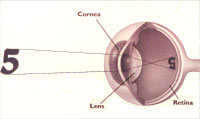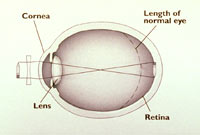
Myopia is the medical term for what is also commonly known as nearsightedness. Simply explained, myopia is a condition that results in a person seeing objects clearly at close range but not at a distance.
The more myopic the eye is, the more blurry distant objects will appear. Reading materials must also be held closer to the eye to be read clearly.
To understand why this is so, let us look at how the normal eye works. When the normal eye perceives a distant object, the parallel light rays that reach the eye from the object viewed will first pass through the refractive surfaces of the cornea and crystalline lens. They are then bent and brought to a clear focus on the retina as an inverted image, very much the same way that a camera works.

In the normal eye, the image is brought to a clear focus on the retina.
However, the myopic eye is more elongated. This causes the light rays to be focused in front of the retina. As a result the image that falls on the retina is out of focus and blurry vision results. It is interesting to note that just a one millimeter increase in the axial length of the eye translates into an increase of –2.50 dioptres (250 degrees) of myopia.

The eyeball is more elongated in myopia. The image here is focused in front of rather than onto the retina.
Near vision is sharper because the more divergent rays of light that reach the eye from near objects effectively serve to push the focus pint backwards onto the retina. This same principle is applied when using concave (minus) lenses to correct myopia. A concave lens of the appropriate power is placed in front of the eye to diverge the parallel rays of light that reach the eye from the distant objects. This causes the focus point to be pushed further back so that they fall to a clear focus on the retina.Unfortunately, the progressive elongation of the eye that accompanies myopia progression is irreversible. The more severe the myopia, the more elongated will be the eye. Most of the blinding complications of myopia such as retinal tears, retinal detachment and myopic macular degeneration are related to this excessive elongation of the eyeball.

To correct myopia, a concave lens is used to diverge light rays to push the image focus back onto the retina for clear vision.
Symptoms of the Myopic Eye
The primary symptom of the myopic eye is blurred distance vision. The worse the myopia, the more blurred the distance vision.

Suspect myopia if your child likes to read up close.
Children usually first notice their myopia when they find that they cannot see as well in the distance as their friends. There may be difficulty recognizing bus numbers from a distance or copying notes from the board up front in the classroom. Toddlers and pre-school children are often unaware of their condition. Parents are instead alerted when they notice abnormal squinting of eyes, abnormal face turn or head tilt and frequent blinking or rubbing of eyes. There may be a preference to watch TV at close distances or frequent complaints of eye strain and headaches.Reading materials may need to be held at uncomfortably close distances to the eyes to be seen clearly. A child suffering from mild myopia, i.e. –2.50 (250 degrees) or less, can still see clearly at the normal comfortable reading distance of 40cm without glasses. However, once myopia exceeds –3.00 dioptres (300 degrees), reading materials will need to be held uncomfortable close to the eyes if glasses are not worn. For example, if a child with –5.00 dioptres (500 degrees) of myopia chooses to read without his glasses, he will have to hold the book at a strenuous 20 cm distance from his eyes. The poor child who suffers from –10 dioptres (1,000 degrees) of myopia will have to hold the book almost up to his nose at a distance of 10 cm to read the words clearly!

